
About Tuberculosis
Ang TB ay isang uri ng sakit na dulot ng mikrobyong Mycobacterium tuberculosis na madalas makaapekto ng baga.Maaari ring maapektuhan ang ibang bahagi ng katawan gaya ng buto, utak, bato, at atay.Alamin ang tamang impormasyon para sa iyong matagumpay na paggaling.

► Paano nakakahawaang TB?
Ang TB ay naipapasa kung ang isang tao ay makalanghap ng mikrobyo ng TB na nasa hangin galing sa ubo o bahing ng taong may TB
► Tandaan na ang TB ay
- HINDI namamana.
- HINDI nakukuha sa pagpapagod, pagpupuyat, o pagkatuyo ng pawis sa likod.
- HINDI naipapasa sa paggamit ng kubyertos o baso ng taong may TB.
- HINDI nakukuha sa kagat ng lamok.
- HINDI naipapasa sa paggamit ng damit o kumot ng taong may TB.
► Paano nakakahawaang TB?
Ang TB-DOTS o Tutok Gamutan ang pinakamabisang paraan para magamot ang TB. Kailangan lamang ng di bababa sa 6 buwang tuloy-tuloy na gamutan. Iinumin ang mga gamot para sa TB araw-araw sa gabay ng health service provider. Importanteng hindi mahinto ang gamutan upang hindi umabot sa pagiging drug resistant ang TB (DR-TB), dahil magiging mas matagal ang gamutan (hanggang 24 na buwan) o maging dahilan ng iyong pagkamatay.
► Ano ang mga side effects ng gamutan?
Posible na ikaw ay makaranas ng mga side effects gaya ng pangangati ng balat, kawalan ng gana kumain, pamamanhid ng paa, at iba pa. Ito ay panandalian lamang at di kailangan ikabahala. Importanteng ipaalam sa iyong health service provider ang iyong mga nararamdaman upang malunasan ito kaagad.
► Ano ang mangyayari pag hindi mo tinapos ang gamutan?
Kapag hindi nakumpleto nang tama ang pagpapagamot, maaaring maging Multi-Drug Resistant (MDR) na ang TB mo. Kapag umabot na sa MDR-TB, hindi na magiging mabisa ang mga gamot na kasalukuyan mong iniinom.
► Patient-centered care
Ang inyong health service provider (HSP) ay nakahandang magbigay sa iyo ng alagang makatao, kaya mahalagang maipahiwatig sa kanya ang mga posibleng maging problema o hadlang sa iyong gamutan. Matutulungan kayo ng inyong health service provider na tugunan ang posibleng mga hadlang sa iyong gamutan.
► Mga Responsibilidad mo Bilang Pasyente
- Ipaalam ang mga nauukol na impormasyon sa iyong health service provider, gaya ng mga nakaraang at kasalukuyang karamdaman.
- Sundan ang schedule ng pag-inom ng gamot araw-araw para masiguro ang paggaling.
- Tumulong sa pag-iwas sa pagkalat ng TB sa komunidad sa pamamagitan ng paghikayat sa mga kakilalang nagpapakita ng sintomas ng TB na kumonsulta agad sa Center.
- Makiisa sa mga kapwa pasyente sa pamamagitan ng pagsuporta sa kanilang pagpapagaling at pagbahagi ng tamang kaalaman na natutunan habang nagpapagamot.
► Bilang pasyente, karapatan mong
- Magamot nang tama at libre na naaayon sa International Standards for Tuberculosis Care.
- Tumanggap ng makataong serbisyo nang walang diskriminasyon o panghuhusga.
- Mabigyan ng tama, malinaw, at napapanahong impormasyon tungkol sa TB, ireresetang gamot, at posibleng side effects nito.
- Base sa mga ibinabahaging mga alternatibo, pumili ng naaangkop na gamutan at ang magiging epekto nito.
- Pangalagaan ang iyong pribadong buhay at karangalan tungkol sa iyong kondisyong medikal.
- Makamit ang hustisya at lunas kung nalabag ang karapatan mo bilang pasyente.
- Mabigyan ng seguridad sa trabaho pagkatapos ng gamutan at rehabilitasyon.
► If I have TB, what can I do to prevent spreading it to other people?
If you are infectious while you are taking rest at home, you can do the following things to protect others near you.• Take your medicines as directed. This is very important!
- Always cover your mouth with a tissue when you cough, sneeze, or laugh. Put the tissue in a closed bag and throw it away safely.
- Isolate yourself from others and avoid close contact with anyone. Sleep in a bedroom away from other family members for the first few weeks.
- Air out your room often to the outside of the building (if it is not too cold outside). TB spreads in small closed spaces where air doesn’t move.
- Put a fan in your window to blow out air that may be filled with TB bacteria. If you open other windows in the room, the fan also will pull in fresh air. This will reduce the chances that TB bacteria will stay in the room and infect someone who breathes the air.
► Am I protected from TB if I have been vaccinated with BCG?
BCG is a vaccine for TB, routinely given to infants and small children. BCG vaccine protects against the severe, life-threatening forms of extra-pulmonary TB such as TB meningitis and miliary TB in childhood. However, it is unreliable protection against pulmonary TB, the main form of tuberculosis.
Source: World Health Organization, 2013
► How can MDR-TB be prevented?
The most important thing a person can do to prevent the spread of MDR-TB is to take all their medications exactly as prescribed by their health-care provider. No doses should be missed and treatment should never be stopped early. Patients should tell their health-care provider if they are having trouble taking the medications. If patients plan to travel, they should talk to their health-care providers and make sure they have enough medicine to last while away.
Health-care providers can help prevent MDR-TB by quickly diagnosing cases, following recommended treatment guidelines, monitoring patients’ response to treatment, and making sure therapy is completed.
Another way to prevent getting MDR-TB is to avoid exposure to known MDR-TB patients in closed or crowded places such as hospitals, prisons, or homeless shelters. If you work in hospitals or health- care settings where TB patients are likely to be seen, you should consult infection control or occupational health experts. Ask about administrative and environmental procedures for preventing exposure to TB. Once those procedures are implemented, additional measures could include using personal respiratory protective equipment.
Source: World Health Organization, 2013
► Can tuberculosis be cured?
Yes. TB can be cured if the full course of the prescribed drugs is taken regularly, and without interruption. The WHO-approved standardized and effective cure for TB, called DOTS (directly-observed treatment, short-course) is available in all countries of the South-East Asia Region.
It takes at least 6–8 months of medication to completely treat the disease. It is very important that the patient takes all the prescribed drugs for the recommended duration.
It is dangerous, both for the patient, family members and the community, if he/she stops taking medication before the prescribed course is completed and without medical advice. The TB germs that are still alive become even stronger, or “resistant” to the drugs. Stronger drugs are then needed to kill these “super” TB germs if the treatment is not completed the first time.
Source: World Health Organization, 2013
► What is DOTS?
DOTS (directly-observed therapy, short-course) means that the patient taking the medicine should be observed by a nominated person, and the taking of the medicine should be recorded. This ensures that the patient takes the medication regularly, which is essential for the medicines to be effective – and to prevent the bacteria from becoming resistant and the drug from becoming ineffective.
The best way to remember to take medicines is to get directly-observed therapy. If following the DOTS regimen, the patient will meet with a health care worker every day or several times a week. This can be at the TB clinic, your home or work, or any other convenient location. You will take your medicines at this place while the health care worker observes.
DOTS helps in several ways. The health care worker can help the TB patient remember to take the medicines and complete the treatment. This means he/she will get well as soon as possible. The health care worker will make sure that the medicines are working as they should. This person will also watch for side-effects and answer questions about TB.
The TB patient must be checked at different times to make sure everything is going well. He/ she should see their doctor or nurse regularly while taking the medicines. This will continue until the patient is cured.
Source: World Health Organization, 2013
► How is TB disease treated?
Tuberculosis is usually treated through the use of a combination of several drugs called antibiotics to kill all the bacteria and preventing them from becoming resistant to one or more drugs.
The most common drugs used to fight TB are:
- Isoniazid
- Rifampin
- Pyrazinamide
- Ethambutol
- Streptomycin
► National Tuberculosis Control Program
The National Tuberculosis Control Program, organized in 1978 and operating within a devolved health care delivery system, is one of the public health programs managed and coordinated by the Infectious Diseases for Prevention and Control Division (IDPCD) of the Disease Prevention and Control Bureau (DPCB) of the Department of Health (DOH).
► The NTP has the following mandates:
- Develop policies, standards, and national strategic plan
- Manage program logistics
- Provide leadership and technical assistance to the lower health offices/units
- Manage data and use the information to inform programmatic activities
- Conduct monitoring and evaluation
► Our Vision
A Tuberculosis-Free Philippines
Zero deaths, disease, and suffering due to tuberculosis
► Goals
Long-Term Goal (2035)
Reduce TB burden by decreasing TB mortality by 95% and TB incidence by 90%.
Medium-Term Goals (2022)
Reduce TB burden by:
- Decreasing the number of TB deaths by 50% from 22,000 to 11,000
- Decreasing TB incidence rate by 15% from 554/100,000 to 470/100,000
- Reduce catastrophic costs incurred by TB-affected households from 35% to 0%.
- At least 90% of patients are satisfied with the services of the DOTS facilities.
► Objectives
Specific Objectives by 2022
- Improve the utilization of TB care and prevention services by patients and communities.
- Reduce the catastrophic cost of TB-affected households accessing DOTS facilities to 0%.
- Ensure adequate and competent human resources for TB elimination efforts.
- Improve the use of TB data for effective TB elimination efforts.
- Enhance the quality of all TB care and prevention services.
- Increase to at least 90% of DOTS facilities that provide expanded integrated patient-centered TB care and prevention services.
- Enhance the political stewardship through a high-level political commitment of national government agencies and LGUs to implement localized TB elimination plans in coordination with different sectors.

Rules and Regulations Governing the Licensure of Primary Care Facilities in the Philippines

Monthly Reporting of Inventory of TB Commodities and Case Management Data through Integrated Tuberculosis Information System of PMDT Health Facilities

Use of Integrated TB Information System (ITIS) Helpdesk
Health Programs Against TB
More about Tuberculosis
Resources

















